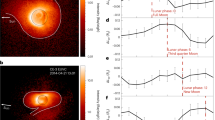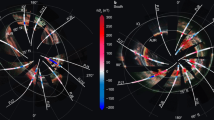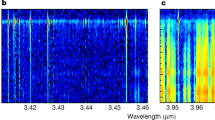Abstract
The icy surface of Jupiter’s moon, Europa, is thought to lie on top of a global ocean1,2,3,4. Signatures in some Hubble Space Telescope images have been associated with putative water plumes rising above Europa’s surface5,6, providing support for the ocean theory. However, all telescopic detections reported were made at the limit of sensitivity of the data5,6,7, thereby calling for a search for plume signatures in in-situ measurements. Here, we report in-situ evidence of a plume on Europa from the magnetic field and plasma wave observations acquired on Galileo’s closest encounter with the moon. During this flyby, which dropped below 400 km altitude, the magnetometer8 recorded an approximately 1,000-kilometre-scale field rotation and a decrease of over 200 nT in field magnitude, and the Plasma Wave Spectrometer9 registered intense localized wave emissions indicative of a brief but substantial increase in plasma density. We show that the location, duration and variations of the magnetic field and plasma wave measurements are consistent with the interaction of Jupiter’s corotating plasma with Europa if a plume with characteristics inferred from Hubble images were erupting from the region of Europa’s thermal anomalies. These results provide strong independent evidence of the presence of plumes at Europa.
This is a preview of subscription content, access via your institution
Access options
Access Nature and 54 other Nature Portfolio journals
Get Nature+, our best-value online-access subscription
$29.99 / 30 days
cancel any time
Subscribe to this journal
Receive 12 digital issues and online access to articles
$119.00 per year
only $9.92 per issue
Buy this article
- Purchase on Springer Link
- Instant access to full article PDF
Prices may be subject to local taxes which are calculated during checkout



Similar content being viewed by others
References
Khurana, K. K. et al. Induced magnetic fields as evidence for subsurface oceans in Europa and Callisto. Nature 395, 777–780 (1998).
Carr, M. H. et al. Evidence for a subsurface ocean on Europa. Nature 391, 363–365 (1998).
Pappalardo, R. T. et al. Does Europa have a subsurface ocean? Evaluation of the geological evidence. J. Geophys. Res. 104, 24105–24055 (1999).
Kivelson, M. G. et al. Galileo magnetometer measurements strengthen the case for a subsurface ocean at Europa. Science 289, 1340–1343 (2000).
Roth, L. et al. Transient water vapor at Europa’s south pole. Science 343, 171–174 (2014).
Sparks, W. B. et al. Probing for evidence of plumes on Europa with HST/STIS. Astrophys. J. 829, 121 (2016).
Sparks, W. B. et al. Active cryovolcanism on Europa? Astrophys. J. Lett. 839, L18 (2017).
Kivelson, M. G., Khurana, K. K., Means, J. D., Russell, C. T. & Snare, R. C. The Galileo magnetic field investigation. Space Sci. Rev. 60, 357–383 (1992).
Gurnett, D. A. et al. The Galileo plasma wave investigation. Space Sci. Rev. 60, 341–355 (1992).
Roth, L. et al. Orbital apocenter is not a sufficient condition for HST/STIS detection of Europa’s water vapor aurora. Proc. Natl Acad. Sci. USA 111, E5123–E5132 (2014).
Spencer, J. R., Tamppari, L. K., Martin, T. Z. & Travis, L. D. Temperatures on Europa from Galileo photopolarimeter-radiometer: nighttime thermal anomalies. Science 284, 1514–1516 (1999).
McGrath, M. & Sparks, W. B. Galileo ionosphere profile coincident with repeat plume detection location at Europa. Res. Notes AAS 1, 14 (2017).
Blöcker, A., Saur, J. & Roth, L. Europa’s plasma interaction with an inhomogeneous atmosphere: development of Alfvén winglets within the Alfvén wings. J. Geophys. Res. 121, 9794–9828 (2016).
Kurth, W. S. et al. The plasma wave environment of Europa. Planet. Space Sci. 49, 345–363 (2001).
Kivelson, M. G., Khurana, K. K. & Volwerk, M. in Europa (eds Pappalardo, R. T., McKinnon, W. B. & Khurana, K. K.) 545–570 (Univ. Arizona Press, Tucson, AZ, 2009).
Toth, G. et al. Adaptive numerical algorithms in space weather modeling. J. Comp. Phys. 231, 870–903 (2012).
Rubin, M. et al. Self-consistent multi-fluid MHD simulations of Europa’s exospheric interaction with Jupiter’s magnetosphere. J. Geophys. Res. 120, 3503–3524 (2015).
Hall, D. T., Strobel, D. F. & Feldman, P. D., McGrath, M. A. & Weaver, H. A. Detection of an oxygen atmosphere on Jupiter’s moon Europa. Nature 373, 677–679 (1995).
Bagenal, F., Dougherty, L. P., Bodish, K. M., Richardson, J. D. & Belcher, J. M. Survey of Voyager plasma science ions at Jupiter: 1. Analysis method. J. Geophys. Res. 122, 8241–8256 (2017).
Porco, C. C. et al. Cassini observes the active south pole of Enceladus. Science 311, 1393–1401 (2006).
Neubauer, F. M. The sub-Alfvénic interaction of the Galilean satellites with the Jovian magnetosphere. J. Geophys. Res. 103, 19843–19866 (1998).
Grasset, O. et al. JUpiter ICy moons Explorer (JUICE): an ESA mission to orbit Ganymede and to characterise the Jupiter system. Planet. Space Sci. 78, 1–21 (2013).
Pappalardo, R. et al. Science objectives and capabilities of the NASA Europa mission. In Proc. 47th Lunar and Planetary Science Conf. 3058 (Lunar and Planetary Institute, 2016).
Powell, K. G., Roe, P. L., Linde, T. J., Gombosi, T. I. & De Zeeuw, D. L. A solution-adaptive upwind scheme for ideal magnetohydrodynamics. J. Comp. Phys. 154, 284–309 (1999).
Gombosi, T. I. et al. Semirelativistic magnetohydrodynamics and physics-based convergence acceleration. J. Comput. Phys. 177, 176–205 (2002).
Kabin, K. et al. On Europa’s magnetospheric interaction: a MHD simulation of the E4 flyby. J. Geophys. Res. 104, 19983–19992 (1999).
Liu, Y. et al. Two-species, 3D MHD simulation of Europa’s interaction with Jupiter’s magnetosphere. Geophys. Res. Lett. 27, 1791–1794 (2000).
Hall, D. T., Feldman, P. D., McGrath, M. A. & Strobel, D. F. The far-ultraviolet oxygen airglow of Europa and Ganymede. Astrophys. J. 499, 475–481 (1998).
McGrath, M. A., Hansen, C. J. & Hendrix, A. R. in Europa (eds Pappalardo, R. T., McKinnon, W. B. & Khurana, K. K.) 485–505 (Univ. Arizona Press, Tucson, AZ, 2009).
Shematovich, V. I., Johnson, R. E., Cooper, J. F. & Wong, M. C. Surface-bounded atmosphere of Europa. Icarus 173, 480–498 (2005).
Smyth, W. H. & Marconi, M. L. Europa’s atmosphere, gas tori, and magnetospheric implications. Icarus 181, 510–526 (2006).
Cassidy, T. A., Johnson, R. E., McGrath, M. A., Wong, M. C. & Cooper, J. F. The spatial morphology of Europa’s near-surface O2 atmosphere. Icarus 191, 755–764 (2007).
Plainaki, C. et al. The role of sputtering and radiolysis in the generation of Europa exosphere. Icarus 218, 956–966 (2012).
Saur, J., Strobel, D. F. & Neubauer, F. M. Interaction of the Jovian magnetosphere with Europa: constraints on the neutral atmosphere. J. Geophys. Res. 103, 19947–19962 (1998).
Johnson, R. E. et al. in Europa (eds Pappalardo, R. T., McKinnon, W. B. & Khurana, K. K.) 507–528 (Univ. Arizona Press, Tucson, AZ, 2009).
Schilling, N., Neubauer, F. M. & Saur, J. Influence of the internally induced magnetic field on the plasma interaction of Europa. J. Geophys. Res. 113, A03203 (2008).
Dols, V., Bagenal, F., Cassidy, T., Crary, F. J. & Delamere, P. A. Europa’s atmospheric neutral escape: importance of symmetrical O2 charge exchange. Icarus 264, 387–397 (2016).
Schunk, R. & Nagy, A. Ionospheres: Physics, Plasma Physics, and Chemistry (Cambridge Univ. Press, Cambridge, UK, 2009).
Bagenal, F. et al. Plasma conditions at Europa’s orbit. Icarus 261, 1–13 (2015).
Zimmer, C., Khurana, K. K. & Kivelson, M. G. Subsurface oceans on Europa and Callisto: constraints from Galileo magnetometer observations. Icarus 147, 329–347 (2000).
Acknowledgements
We thank M. McGrath for an illuminating presentation at a Europa Clipper Project Science Group meeting on observations of Europa’s plumes, which led us to re-examine the Galileo MAG data on which this paper is largely based. The work at the University of Michigan was supported by NASA through grants #NNX12AM74G and #NNX15AH28G, contract #1532308 through the Jet Propulsion Laboratory and contract #143448 through the Applied Physics Laboratory at Johns Hopkins University. The research at the University of Iowa is supported by NASA through contract UTA16-001080 through the University of Texas at Austin. Additional funding for work at UCLA was provided by NASA grants #NNX13AL05G:000002 and #NNX14AO24G.
Author information
Authors and Affiliations
Contributions
X.J., M.G.K. and K.K.K. contributed to the analysis of the Galileo magnetic field data. W.S.K. analysed the Galileo plasma wave data. X.J. performed the simulations and led the interpretation of the model results. All authors discussed the results and contributed to writing the manuscript.
Corresponding author
Ethics declarations
Competing interests
The authors declare no competing interests.
Additional information
Publisher’s note: Springer Nature remains neutral with regard to jurisdictional claims in published maps and institutional affiliations.
Supplementary information
Supplementary Information
Supplementary Figures 1–5.
Rights and permissions
About this article
Cite this article
Jia, X., Kivelson, M.G., Khurana, K.K. et al. Evidence of a plume on Europa from Galileo magnetic and plasma wave signatures. Nat Astron 2, 459–464 (2018). https://doi.org/10.1038/s41550-018-0450-z
Received:
Accepted:
Published:
Issue Date:
DOI: https://doi.org/10.1038/s41550-018-0450-z
This article is cited by
-
Oxygen production from dissociation of Europa’s water-ice surface
Nature Astronomy (2024)
-
MASPEX-Europa: The Europa Clipper Neutral Gas Mass Spectrometer Investigation
Space Science Reviews (2024)
-
Planned Geological Investigations of the Europa Clipper Mission
Space Science Reviews (2024)
-
Moons and Jupiter Imaging Spectrometer (MAJIS) on Jupiter Icy Moons Explorer (JUICE)
Space Science Reviews (2024)
-
Sustained and comparative habitability beyond Earth
Nature Astronomy (2023)



